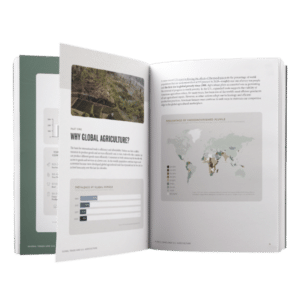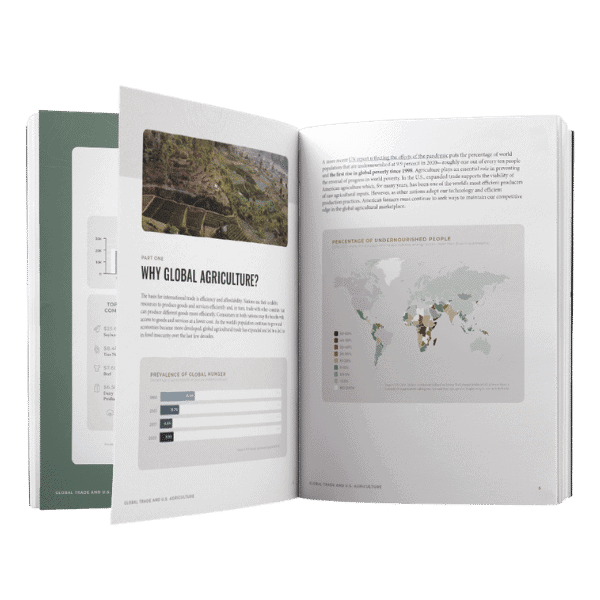Fourth Quarter Update: 2022 Trade Outlook for U.S. Agriculture
Despite slight softening, the outlook for U.S. agricultural exports in fiscal year (FY) 2022 remains at historic highs.
The USDA released its last quarterly report in 2021 on the outlook for U.S. agricultural trade on November 23, 2021. While the revised trade forecast wasn’t quite as optimistic as the previous third quarter trade update, it still projects record-breaking trade for U.S. agriculture in 2022.
Download your free copy of Global Trade and U.S. Agriculture: an economic analysis with insights from AgAmerica’s Chief Economist Dr. John Penson to learn more about what farmers should be keeping an eye on in 2022.

Report Highlights: U.S. Ag Export Trends in 2022
For FY 2022, U.S. ag export sales are expected to reach $175.5 billion—$2 billion lower than the prior prediction but still $1.5 billion higher than the 2021 trade estimate.

On the other hand, total U.S. ag import sales in 2022 were raised to $165 billion—a $5.5 billion increase from the trade report released last August. Because of these changes, the total U.S. agricultural trade surplus was reduced from $18 billion to $10.5 billion.
The U.S. Farm Economy
Ongoing price pressures and supply chain issues are the main contributors to these changes. However, despite revised projections, the farm economy outlook remains strong in 2022. Signs of global economic recovery are evident, with world gross domestic product (GDP) projected to increase 5.9 percent in 2021 and 4.9 percent in 2022. U.S. GDP projections are even higher at 6 percent in 2021.
A $10.5 billion agricultural trade surplus still surpasses the 2021 ag trade estimate of $8.9 billion. The increase in U.S. ag imports is attributed to higher import sales for horticultural and livestock products. Imported distilled spirits and fresh fruit were among the highest increases, along with beef and pork in the livestock sector. Reduced oilseed and oilseed product export demand was among the key reasons contributing to the decline of U.S. ag export trade in 2022. This softening in demand was partially offset by increasing sales of livestock, poultry, dairy, cotton, and ethanol exports.
Commodity Deep Dives
Grain and feed: Corn, sorghum, and rice export sales estimates are down $100 million each, while wheat remains unchanged. Higher unit values are being offset by lower volumes and more competition in the global ag trade market.
Soybeans: The export trade estimate for U.S. soybeans was lowered to $28.9 billion, a $3.9 billion drop attributed to lower prices and softening demand from China.
Livestock: U.S. beef export sales estimate increased by $800 million due to higher prices. Hides and skins exports also increased to $1.1 billion as global demand for leather returns alongside economic recovery. Projections for U.S. pork exports fell $500 million to $6.6 billion, likely caused by lower processing demand.
Poultry: Like U.S. beef, U.S. poultry is also experiencing higher export prices, leading to an increase of $700 million in 2022 export sales projections.
Dairy: Dairy product exports are raised $200 million on higher volumes and rising unit values, reflecting strong global demand and tightening competitor supplies.
Cotton: Exorbitant price rallies—both for domestic and international prices—are leading to significantly raised export unit values and an increase of $500 million in U.S. cotton export sales in 2022. Improved U.S. cotton crop conditions are also contributing to higher volumes than previously expected.
Ethanol: The increasing cost of fuel is leading to higher unit values for ethanol, with U.S. ethanol export sales projected to reach a record $2.9 billion in 2022.
Horticultural products: While imports showed a substantial increase, estimated for U.S. horticultural product export sales remained stable at $37.7 billion, as did U.S. tree nut exports at $9 billion.
Trade Partnerships
One of the most interesting takeaways from the USDA Outlook for U.S. Trade quarterly report is the softening in demand from the largest agricultural market for U.S. agricultural exports—China. Anticipated U.S. ag export sales to China in 2022 were dropped $3 billion to $39 billion. While this specific decline is mostly attributed to lower soybean unit values, it is an important reminder of the influence our large trading partners can have on the domestic agricultural market.
Projections for U.S. agricultural exports to Mexico—the largest supplier of U.S. ag imports—in 2022 increased by $1.2 billion to $23.5 billion due to strong demand for livestock, poultry, cotton, and dairy. It’s also important to note that Mexican agricultural import sales are forecasted to be $32.8 billion—$900 million above the August forecast—due to increases in expected imports of produce and distilled spirits.
Understanding the Factors that Shape the Global Trade Market
Competition, supply, demand, and foreign exchange rates are among the interconnected factors that impact the future of the U.S. agricultural trade market. Understanding the roles each of these factors play in the U.S. ag sector can help farmers and ranchers make more informed decisions about their operation as we head into 2022.
Founded with roots in agriculture, AgAmerica is committed to breaking the confines of traditional financing as an advocate for the thriving future of American agriculture. One way we’re doing this is by providing free, informative resources to equip farmers and help them succeed.
Download your free copy of Global Trade and U.S. Agriculture: an economic analysis with insights from AgAmerica’s Chief Economist Dr. John Penson to learn more about what farmers should be keeping an eye on in 2022.







